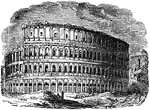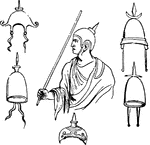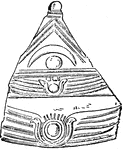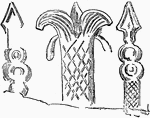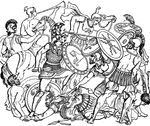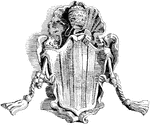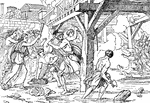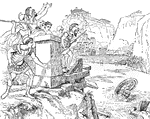
A Roman Soldier, or Legionary, with a Short Javelin and Shield
Illustration of a Roman soldier, also called a legionary, carrying a shield, short sword, and a short…

Flavius Aetius
Flavius Aetius (396-454) was a Roman general of the closing period of the Western Roman Empire.

Publius Cornelius Scipio Africanus
Scipio Africanus (236-183 BC) was a general in the Second Punic War and statesman of the Roman Republic.
!["In order that [Alaric's] body might be saved from the gaze of the vulgar and the rage of his foes, he gave direction that it should be buried in the bed of the river Busentinus."—Ridpath, 1885](https://etc.usf.edu/clipart/78900/78952/78952_alaricburial_mth.gif)
The Burial of Alaric in the Bed of the Busentinus
"In order that [Alaric's] body might be saved from the gaze of the vulgar and the rage of his foes,…
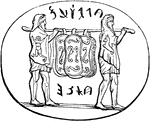
Ancilia
"According to the ancient authorities, it was made of bronze, and its form was oval, but with the two…
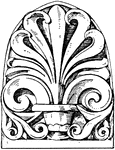
Roman Antefix
The Roman antefix is is found in the temple of Jupiter Stator in Rome, Italy. This design is found on…

Antinous
"It was during Hadrian's sojourn in this country that his favorite, the beautiful Birthynian named Antinous,…

Marcus Aurelius Antoninus
"Marcus Aurelius Antoninus stands almost alone in the history of the world as a philosopher and philanthopist…

Apoxyomenos
An ancient sculpture representing an athlete using a strigil to scrape sweat and dust off his body.
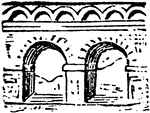
Aqueduct
"A conduit for conveying water more particularly applied to structures for conveying water from distant…
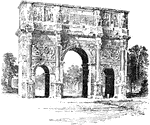
Arch of Constantine
The Arch of Constantine is a triumphal arch in Rome between the Colosseum and the Palatine Hill.

Auger
"Among the anceient Romans, a functionary whose duty it was to observe and to interpret, according to…

Roman augur
"Represents a Roman augur, with his litmus or divining staff, observing the signs in the heavens." —…
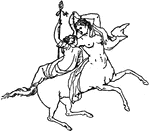
Centuars and Bacchantes
The Centaurs and Bacchantes comes from mural paintings found in ancient Pompeii, Rome. It is imaginary…
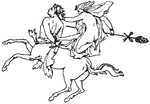
Multiple Centuars and Bacchantes
The two Centaurs and Bacchantes comes from mural paintings found in ancient Pompeii, Rome. It is imaginary…

Ballista
The Ballista is a device for throwing large darts very accurately. The Roman Ballistas threw stones…
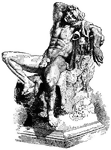
The Barberini Faun, or Drunken Satyr
Illustration of the life-size marble statue located in Munich, Germany. It was found in 1620 in a moat…

Roman Base
This Roman base is a design found in the Capitalone museum of Rome, Italy. It is a design of leaves…

Roman Base
This Roman base is found in the Temple of Concord in Rome, Italy. It is a natural method of decoration,…
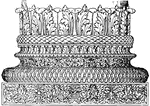
Roman Base
This Roman base is found in the Baptistery of Constantinople, Rome, Italy. It is a natural method of…
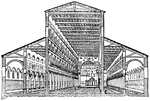
Basilica
"Sectional view of the old Basilica of St. Peter, before its destruction in the 15th century." —…

Basilica
"Sectional view of the old Basilica of St. Peter, before its destruction in the 16th century." —…

Basilica of Constantine
"Section of the Basilica of Maxentius or Constantine (Temple of Peace)." — Encyclopediia Britannica,…

Basilica of Old St Peter
"Sectional view of the old Basilica of St. Peter, before its destruction in the 16th century." —…

St. Peter's Basilica
The St. Peter's Basilica is located within the Vatican city in Rome, Italy. This drawing shows the architecture…

Blind Belsarius
Belsarius was ordered to have his eyes put out, and was reduced to a homeless beggar.

A Bishop Sitting on a Bishop's Throne Called a Cathedra
Illustration of a bishop sitting on an ornately decorated cathedra. A crosier, pastoral staff, rests…

Antique Serpent Bracelet
This Serpent antique bracelet is in the form of a viper. It came from Pompeii, Rome.

Donato Bramante
(1444-1514) Italian architect who introduced the Early Renaissance style to Milan and the High Renaissance…
!["After a successful summer campaign, [Caesar] made his way to the coast and cross over into Britain. He then withdrew into his winter-quarters in Gaul, but in the following year returned into the island, defeated the British Celts under their king Cassivellaunus, and reduced the country to a dependency, compelling the Britons to pay tribute and give hostages."](https://etc.usf.edu/clipart/78900/78943/78943_landing_01_mth.gif)
Landing of the Romans in Britain
"After a successful summer campaign, [Caesar] made his way to the coast and cross over into Britain.…
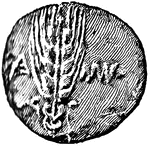
British Coin
British coin of the time period of the Roman invasion in the Gallic War, B.C. 54. Front.
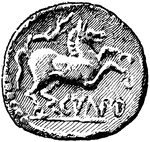
British Coin
British coin of the time period of the Roman invasion in the Gallic War, B.C. 54. Back.
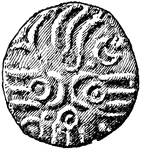
British Coin
British coin of the time period of the Roman invasion in the Gallic War, B.C. 54. Front.



